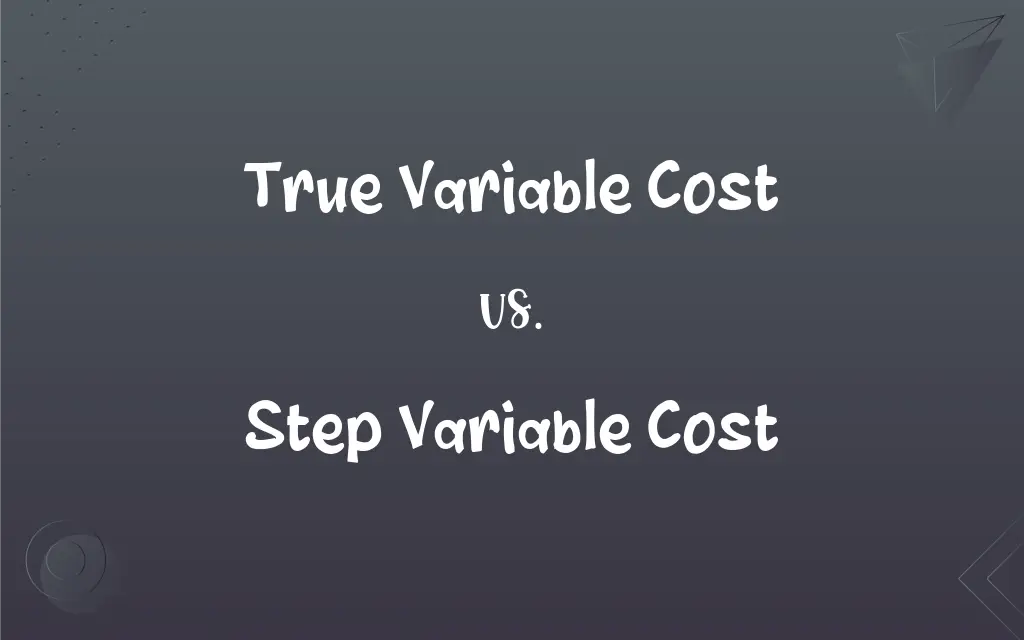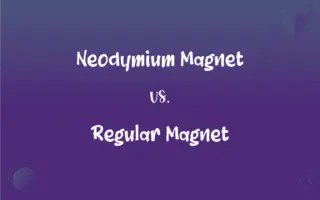True Variable Cost vs. Step Variable Cost: What's the Difference?
Edited by Aimie Carlson || By Harlon Moss || Published on December 12, 2023
True variable costs vary directly with production volume, while step variable costs change in steps with production levels.

Key Differences
True variable costs change in direct proportion to production levels, whereas step variable costs change in fixed increments or steps as production levels reach certain thresholds.
True variable costs show a continuous change, increasing or decreasing smoothly with production levels. In contrast, step variable costs remain constant over a range and then jump to a new level.
An example of a true variable cost is raw material costs, which vary directly with the amount produced. Step variable costs, like labor costs, might remain constant until a new production level necessitates additional staffing.
In budgeting, true variable costs are more predictable and linear, while step variable costs require careful planning for the points at which costs will increase.
True variable costs can be calculated per unit of production, offering a straightforward analysis. Step variable costs need a range-based approach, considering the levels at which costs change.
ADVERTISEMENT
Comparison Chart
Relation with Production
Changes in direct proportion to production level
Changes in steps at certain production thresholds
Nature of Change
Continuous
Discontinuous, in fixed increments
Predictability
More predictable and linear
Less predictable, requires planning for cost jumps
Example
Raw material costs
Labor costs in relation to production tiers
Budgeting and Cost Analysis
Calculated per unit, easier to analyze
Requires analysis of ranges and thresholds
ADVERTISEMENT
True Variable Cost and Step Variable Cost Definitions
True Variable Cost
Calculated on a per-unit basis.
The cost of ink per printed book is a true variable cost.
Step Variable Cost
Remains constant over a range, then jumps.
The cost of supervisory staff increases only after reaching a certain production threshold, a step variable cost.
True Variable Cost
Costs that vary directly with production.
The cost of fabric for each shirt made is a true variable cost.
Step Variable Cost
Requires planning for thresholds.
The addition of new delivery vehicles for every 1,000 orders is a step variable cost.
True Variable Cost
Changes linearly with production levels.
As production doubles, the true variable cost for raw materials also doubles.
Step Variable Cost
Not directly proportional to production.
The cost of technical support staff, added in tiers based on production volume, is a step variable cost.
True Variable Cost
Directly proportional to output.
The more units produced, the higher the true variable cost for materials.
Step Variable Cost
Involves thresholds at which costs change.
Maintenance costs increase only after every 10,000 units, illustrating step variable costs.
True Variable Cost
Reflects the actual usage of resources.
Electricity costs for running machinery are a true variable cost in manufacturing.
Step Variable Cost
Costs that change in fixed steps with production levels.
Hiring an additional worker after every 500 units produced is a step variable cost.
FAQs
How does a true variable cost behave with increased production?
It increases linearly.
What is a step variable cost?
A cost that changes in fixed steps at certain production levels.
Can true variable costs be easily predicted?
Yes, due to their direct relation with production.
Are step variable costs predictable?
Less so, as they depend on production thresholds.
How do true variable costs impact budgeting?
They allow for more straightforward budgeting per unit.
What is an example of a true variable cost?
Raw materials cost.
What is a true variable cost?
A cost that varies directly with production volume.
How does a step variable cost behave with increased production?
It remains constant until a threshold is reached, then jumps.
How do step variable costs impact budgeting?
They require planning for cost jumps at certain points.
Is electricity a true variable cost in manufacturing?
Yes, as it varies with production levels.
What is an example of a step variable cost?
Labor costs that increase at certain production levels.
Is hiring additional staff a step variable cost?
Yes, if it occurs at specific production intervals.
Can step variable costs be avoided?
Not easily, as they are linked to necessary production increases.
Do true variable costs have thresholds?
No, they change continuously with production.
Are step variable costs more common in certain industries?
Yes, especially in those with tiered production processes.
Do step variable costs have thresholds?
Yes, they change at specific production points.
How are true variable costs calculated?
Per unit of production.
How are step variable costs analyzed?
By considering production ranges and thresholds.
Can true variable costs fluctuate greatly?
They fluctuate in proportion to production volume.
Are true variable costs common in all industries?
Yes, in most industries that involve production.
About Author
Written by
Harlon MossHarlon is a seasoned quality moderator and accomplished content writer for Difference Wiki. An alumnus of the prestigious University of California, he earned his degree in Computer Science. Leveraging his academic background, Harlon brings a meticulous and informed perspective to his work, ensuring content accuracy and excellence.
Edited by
Aimie CarlsonAimie Carlson, holding a master's degree in English literature, is a fervent English language enthusiast. She lends her writing talents to Difference Wiki, a prominent website that specializes in comparisons, offering readers insightful analyses that both captivate and inform.








































































